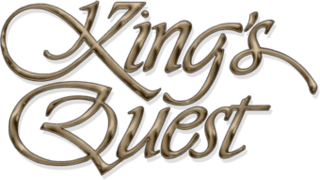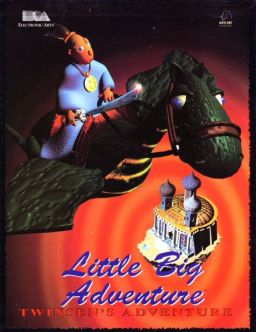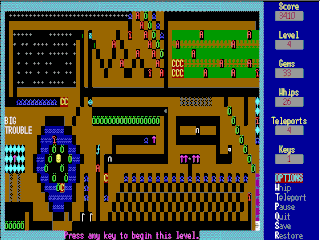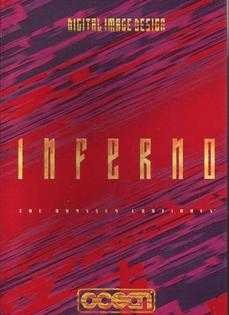
Duke Nukem 3D is a first-person shooter video game developed by 3D Realms. It is a sequel to the platform games Duke Nukem and Duke Nukem II, published by 3D Realms.

King's Quest is a graphic adventure game series, released between 1980 and 2016 and created by the American software company Sierra Entertainment. It is widely considered a classic series from the golden era of adventure games. Following the success of its first installments, the series was primarily responsible for building the reputation of Sierra. Roberta Williams, co-founder and former co-owner of Sierra, designed all of the King's Quest games until the series' reboot in 2015.

Catacomb 3-D is a first-person shooter video game, the third in the Catacomb series, the first of which to feature 3D computer graphics. It was developed by id Software and originally published by Softdisk under the Gamer's Edge label, released in November 1991. The player takes control of the high wizard Petton Everhail, descending into the catacombs of the Towne Cemetery to defeat the evil lich Nemesis and rescue his friend Grelminar.

Under a Killing Moon is a 1994 point-and-click adventure interactive movie video game. It is the third installment in the Tex Murphy series of adventure games produced by Access Software. In it, the detective Tex Murphy finds himself unwittingly involved in the affairs of a dangerous cult.

Titanic: Adventure Out of Time is a 1996 point-and-click adventure game developed by CyberFlix and published in the United States and United Kingdom by GTE Entertainment and Europress respectively, for Windows and Macintosh. It takes place in a virtual representation of the RMS Titanic, following a British spy who has been sent back in time to the night Titanic sank and must complete a previously failed mission to prevent World War I, the Russian Revolution, and World War II from occurring. The gameplay involves exploring the ship and solving puzzles. There are multiple outcomes and endings to the game depending on the player's interactions with characters and use of items.

Little Big Adventure is a 1994 action-adventure game developed by Adeline Software International. It was published in Europe by Electronic Arts, and by Activision in North America, Asia and Oceania under the name Relentless: Twinsen's Adventure. Over 500,000 copies were sold by 1999. The game was initially released on CD-ROM and some time later on floppy disks; the CD-ROM version features full-motion video, music and speech whereas the floppy disk version has MIDI music files and still images to replace the videos. The game was later ported to the PC-98 and FM Towns and was released in Japan in 1995. It was released for the PlayStation in Japan and Europe in 1996 and 1997 respectively, and to Android and iOS devices in 2014.

Albion is a role-playing video game, developed and published by Blue Byte for MS-DOS. Originally released in German in 1995, the game was later translated to English for international release the following year. The game, which mostly involves traditional fantasy elements, such as magic, combined with a science fiction setting, sees players assume the role of a space pilot aboard a mining colony ship, who becomes stranded on a world set to be mined for its resources, despite it teeming with life and sentient races.

Duke Nukem is a 1991 platform game developed and published by Apogee Software for MS-DOS. The 2D, multidirectional scrolling game follows the adventures of fictional character Duke Nukem across three episodes of ten levels each. The game's first episode was distributed as shareware. The name was briefly changed to Duke Nukum to avoid trademark issues.

Balls of Steel is a pinball computer game developed by Wildfire Studios and released on December 12, 1997. It is the only game to be published under the Pinball Wizards label, a division of Apogee Software.

Kroz is a series of Roguelike video games created by Scott Miller for IBM PC compatibles. The first episode in the series, Kingdom of Kroz, was released in 1987 as Apogee Software's first game. It was also published on Big Blue Disk #20. Kroz introduced the scheme of the first episode being free and charging money for additional episodes, a technique which defined the business model for Apogee and was adopted by other MS-DOS shareware publishers.

Tex Murphy is a series of video games designed by Chris Jones. The eponymous main character is portrayed in live-action by Chris Jones himself. He is characterized as a down-on-his-luck private investigator in a post-nuclear future San Francisco, borrowing tropes from both the film noir and cyberpunk genres.

The Pandora Directive is the fourth installment in the Tex Murphy series of graphic adventure games produced by Access Software. After its creators reacquired the rights to the series, it was re-released on Good Old Games in July 2009.

Frédérick Raynal is a French video game designer and programmer, notable for his game developments in Infogrames, Adeline Software International and No Cliché. He is married to Yaël Barroz, a fellow game designer, with whom he has two children.

Dark Savior is a 3D mixed-genre video game for the Sega Saturn created by Climax Entertainment. It was referred to by GameSpot as a sequel to the developer's game for the Sega Mega Drive/Genesis, Landstalker: The Treasures of King Nole, even though the games' storylines are unrelated and their gameplay is considerably different.

Hellfire, often called Diablo: Hellfire, is an expansion pack for the video game Diablo, developed by Synergistic Software, a Sierra division, and published by Sierra On-Line in 1997. Despite the objections of Blizzard Entertainment, the Hellfire expansion was produced, permitted by Davidson & Associates, their parent company at the time. Blizzard North, who was developing the sequel Diablo II, thus imposed numerous restrictions upon Synergistic Software's development of Hellfire.

Inferno is a space combat simulator video game developed by Digital Image Design and published by Ocean Software in 1994 for the PC. It is a sequel to the 1992 game Epic.

LittleBigPlanet (LBP) is a puzzle platform video game series created and produced by British developer Media Molecule and published by Sony Interactive Entertainment. Most games in the series put a strong emphasis on user-generated content and are based on the series' tagline "Play, Create, Share". The tagline represents the three core elements of the series: playing alone or with others locally or online, creating new content using the in-game creation tools, and sharing creations and discoveries online with other players.

Eternam is a graphical adventure game from Infogrames, released originally in 1992 for MS-DOS. A CD-ROM version with full speech was published in 1993. The game was developed by Hubert Chardot, who is better remembered from his Lovecraft-themed games Shadow of the Comet and Prisoner of Ice. While the game is mainly a two-dimensional adventure game, it contains a three-dimensional subgame, which pays homage to Drakkhen, a roleplaying game from Infogrames. This game was re-released digitally on GOG.com in mid 2019.

Alien Odyssey is an action-adventure game developed by Argonaut Software and published by Philips Media in 1995. The game features a mixture of first-person and third-person gameplay, with sequences involving shooter, adventure and puzzle mechanics. Alien Odyssey makes use of 3D rendering and full motion video cutscenes which were developed using the developer's proprietary B-Render graphics software. Upon release, the game received a mixed reception, with reviewers praising the visual presentation of the game, whilst critiquing the game's inconsistent mixture of game modes and short length.



















